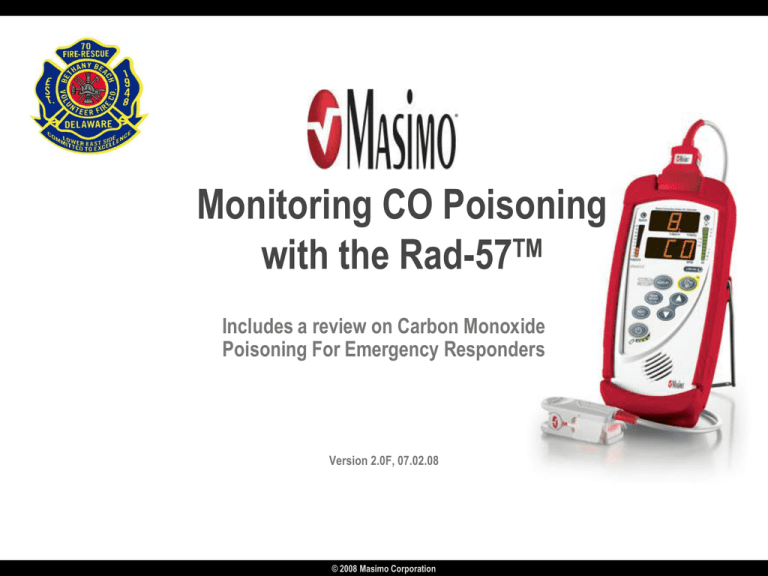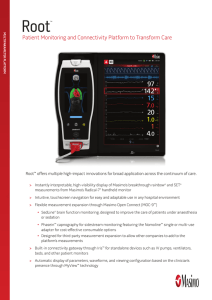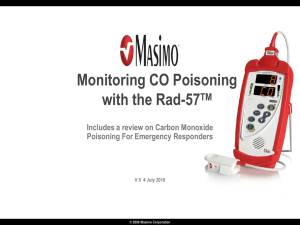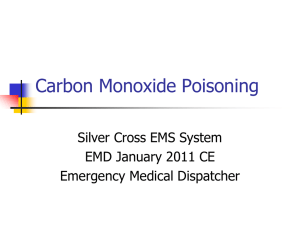
Monitoring CO Poisoning
with the Rad-57TM
Includes a review on Carbon Monoxide
Poisoning For Emergency Responders
Version 2.0F, 07.02.08
© 2008 Masimo Corporation
IMPORTANT NOTICE
• This program is not meant as a substitute for a program or
course of study in carbon monoxide recognition and treatment,
or emergency medicine. This is for review only. Please refer to
your physician or local Medical Director for approved content
and medical protocols.
• This program is not meant as a substitute for the
manufacturer’s operator manual for the Masimo Rad-57. Please
refer to the manufacturer for complete operating instructions.
• There are two versions of operating software that also include
faceplate changes. Please review slide 28 for key version
differences.
© 2008 Masimo Corporation
Section 1
Review: Carbon Monoxide Poisoning For Emergency Responders
© 2008 Masimo Corporation
Introduction
• Carbon monoxide is the leading cause of poisoning in the United
States for the last 100 years and is a common hazard to First
Responders.
• Until recently, the only way to reliably diagnose carbon monoxide
poisoning was to draw blood and check the carbon monoxide levels
in a lab. With the introduction of the Masimo Rad-57, testing for
carbon monoxide can now be done quickly and easily, allowing for
prompt screening and treatment.
• This training program covers carbon monoxide poisoning
recognition and treatment and the use of the Masimo Rad-57 Pulse
CO-OximeterTM. As always, seek direction and approval from your
physician or Medical Director prior to using this training program or
a Masimo Rad-57.
© 2008 Masimo Corporation
Definition
• Carbon monoxide is a colorless, odorless,
tasteless, toxic gas that, when inhaled, can
cause serious physical problems and even
death.
• Carbon monoxide is often referred to as
“CO”, which is its chemical symbol. Even at
low levels, carbon monoxide may cause longterm cardiovascular and neurological
disorders.
• Carbon monoxide can be a serious and
sometimes deadly threat to Firefighters and
EMS personnel. Firefighters have regular
contact with carbon monoxide at fire and
rescue scenes, increasing their health risks.
© 2008 Masimo Corporation
Common Sources
• Incomplete combustion of any carbon-based material will produce carbon
monoxide. Closed or confined spaces are particularly hazardous. Common
sources are:
• Automobiles, trucks, buses
• Boats, campers
• Gas heaters, furnaces, and hot water heaters
• Gas-powered generators
• Small gasoline engines
• Portable / space heaters
• Barbecues / fireplaces
• Cigarette smoke
• Lanterns
• Methylene chloride (paint stripper)
• Liver converts to CO
• Structure / wildland fires
© 2008 Masimo Corporation
Physiology
• Carbon monoxide is inhaled and
passes from the lungs to the blood
where it binds with hemoglobin
• Produces carboxyhemoglobin
• Affinity to hemoglobin is greater than 200 X
that of oxygen
• Reduces oxygen carrying capacity of blood
• Alters release of remaining oxygen to cells
• Acts as an intracellular toxin
• Poisons tissues and cells
• Binds with myoglobin in muscle
• Interferes with heart and skeletal
muscle
• Immediate threat to life
• Oxygen starvation
• Cardiac arrhythmias
• Alters judgment, reasoning
• Long-term health effects
• Central nervous system damage
• Cardiovascular damage
© 2008 Masimo Corporation
Signs and Symptoms
SpCO % Clinical Manifestations
0-4%
None - Normal
5-9%
Minor Headache
10-19%
20-29%
30-39%
40-49%
50-59%
60% -up
Headache, Shortness of
Breath
Headache, Nausea,
Dizziness, Fatigue
Severe Headache, Vomiting,
Vertigo, ALOC
Confusion, Syncope,
Tachycardia
Seizures, Shock, Apnea,
Coma
Coma, Death
Koster LA, Rupp T.The Silent Killer, Recognizing and Treating Carbon
Monoxide Poisoning. JEMS. October 2005
© 2008 Masimo Corporation
Treatment Considerations
• Scene safety, protect yourself:
• Consider SCBA
• Remove patient away from the poison!
• ABC’s (airway, breathing and circulation)
• Check CO level with Pulse CO-Oximeter
• High levels treated with 100% oxygen:
• Decrease half-life of CO in blood
• Increase delivered oxygen in blood
• Support ventilations as needed
• Transport to closest, most appropriate facility
• Consider hyperbaric treatment center:
• Adults >25%, Pedi & Pregnant female >15%
• Neurologic compromise
• Monitor vital signs and SpCO®
• Always follow local EMS protocols
© 2008 Masimo Corporation
Suggested Triage Algorithm
Measure SpCO
SpCO 0-3%
SpCO >3%
No further medical
evaluation of SpCO
needed
Loss of consciousness
or neurological
impairment or SpCO
>25% ?
No
Yes
Transport on 100%
oxygen for ED
evaluation. Consider
transport to hospital
with hyperbaric chamber
SpCO >12
SpCO <12
Transport on 100%
oxygen for ED
evaluation
Symptoms of CO
exposure?
Yes
No
Transport on 100%
oxygen for ED
evaluation
No further evaluation of
SpCO needed.
Determine source of CO
if nonsmoker
Hampson NB, Weaver LK JEMS 2006
© 2008 Masimo Corporation
Half-Life
• Half-life: The amount of time required
to reduce the blood level of CO by
50%. These are estimates for patients
that otherwise are healthy. Age and
health will impact the half-life of CO.
• Breathing Room Air: Carbon Monoxide
half-life in blood is ~ 240 minutes
• High-flow oxygen (“100%”) via nonrebreather mask: Decreases CO Halflife in blood to 40-60 minutes
• Hyperbaric Oxygen Treatment (HBOT)
at 2.5 to 3 Atmospheres: Decreases CO
half-life in blood to 20 -24 minutes
© 2008 Masimo Corporation
Understanding PPM & SpCO
• PPM or “Parts Per Million” is the
atmospheric concentration of the gas
• PPM is common fireground safety
measurement, often misleading as CO
forms in pockets
• SpCO - noninvasive measurement of CO in
the blood
• SpCO as measured by RAD-57 is a function
of PPM CO and total time of exposure of the
poison
• Age, health and respiratory rate may be a
factor
• Even low PPM levels can lead to high SpCO
if exposure is long enough, common in
overhaul
• Even an exposure of 50 PPM for 60 minutes
requires assessment and possible medical
treatment with oxygen
© 2008 Masimo Corporation
Firefighter Risk
• CO levels may be highest during the post-fire or
“overhaul” phase, search & rescue operations
and wildland firefighting
• Periods that self-contained breathing apparatus
(SCBA) are not worn or not functioning properly
• CO poisoning is often unrecognized due to the
presence of exhaustion, heat stress, illness or
injuries
• Studies have shown low levels of untreated CO
lead to central nervous system and
cardiovascular disease
• Moderate to high levels are immediate threats to
health and safety, and cause cardiovascular
injury
© 2008 Masimo Corporation
Section 2
Overview: Using the Rad-57 Pulse CO-Oximeter
• Note: This is NOT intended to replace or act as a substitute for the
Operators Manual. Please refer to the manufacturer’s Operator
Manual for complete information on the operation and safety of the
Rad-57 Pulse CO-Oximeter.
© 2008 Masimo Corporation
RAD-57 Pulse CO-Oximeter
• The Masimo RAD-57 is the world’s first and only Pulse CO-Oximeter
• Signal Extraction Technology (SET®)
SpO2 (oxygen saturation)
Pulse rate
Measure through motion and low perfusion
• Rainbow® SET Technology
Analyzes 7+ wavelengths of light
Accurately measures carboxyhemoglobin (SpCO) levels
noninvasively, in SECONDS!
• PI (perfusion index, strength of arterial pulse)
• Low Signal IQ® indicator (poor SpO2 signal quality)
• Continuous color-coded CO bar graph
• Adjustable parameter alarms
© 2008 Masimo Corporation
RAD-57 EMS Carry Case
• Lightweight: 13 oz.
• Small: 6.2” x 3.0” x 1.4”
• Portable: operates on 4 “AA”
batteries
• Supplied with high-visibility,
water-resistant protective case
• Protective cover
• Reference card holder
• Department ID holder
• Pen holder
• Spare battery pocket
• Extra sensor pocket
© 2008 Masimo Corporation
RAD-57 Operation / Powering Up
• POWER
• Press to turn ON
• Press and HOLD to turn OFF
• Battery Indicator
• 4 Green LED’s
• Each represents approximately 25%
battery life
• Use only Alkaline batteries
• Do Not use rechargeable batteries
• Battery Compartment
• Located in back panel
• Holds 4 “AA” alkaline batteries
• Operates 8-10 hours
© 2008 Masimo Corporation
RAD-57 Operation / Startup Sequence
• Place sensor on finger (relatively clean & dry)
• Press “Power” button
• Verify All LED’s light up and a 1 second tone
is heard*
• Startup mode begins
• All preset configurations are displayed
• Scrolling zeroes 0 – 0 – 0 and flashes
dashed lines
• May take up to 25 seconds
• Do not move sensor during startup
• When complete reading is displayed
• Begin patient monitoring
• Defaults to pulse rate and oxygen
saturation reading
• “PI” bar graph displays strength of
arterial perfusion
* Refer to operator’s manual for additional verifications prior to patient monitoring.
© 2008 Masimo Corporation
RAD-57 Operation / Sensor Placement
Optimal LED path
• Sensor placement is very
IMPORTANT
• When possible, use ring finger,
non-dominant hand
• Insert finger until the tip of finger
hits the STOP Block
• Sensor should not rotate or move
freely on finger
• LED’s (red light) should pass
through mid-nail, not cuticle
• There is a top and bottom, cable
should be on top (nail side)
© 2008 Masimo Corporation
RAD-57 Operation / Pulse Rate and Saturation
• Display after Startup
• Oxygen Saturation on top in
Red
• Pulse Rate on bottom in Green
• Green PI scale, indicates
strength of arterial pulse
• Low SIQ LED indicates poor
SpO2 signal quality
• Press “Display” to display %
carboxyhemoglobin
• Press “Bell” to silence alarms
PI Scale
Low SIQ LED
Alarm Silence LED
Display button
toggles from
SpO2 to SpCO
Battery level
© 2008 Masimo Corporation
RAD-57 Operation / Alarms
• When parameter is violated, audible alarm
will sound, parameter will flash
• Preset at factory:
Alarm Indicator
(flashes)
• Sp02 (oxygen saturation)
• Low: 90%
• High: none
• Pulse Rate
• Low: 50
• High: 140
• SpCO (carboxyhemoglobin)
• Low: none
• High: 10%
• Alarms adjust:
• Press “Mode/Enter” twice
• Press “Next” key to scroll through
parameters
• Use up and down keys to adjust
• Changes remain until user restores to
factory defaults
© 2008 Masimo Corporation
RAD-57 Operation / Measuring CO
Slow: Low SpCO Confidence
Fast: SpCO Alarm
• Press “Display” button for SpCO
reading
• To scroll back to SpO2 mode press
“Display” again
• Carboxyhemoglobin displayed in % on
top
• “CO” displayed on bottom confirming
mode
• Real-time SpCO indicator continuously
reads SpCO
• Green: 1-3%
• Yellow: 4-11%
• Red: 12% and above
• Confirm abnormal readings by taking
several measurements on different
fingers and average the readings
© 2008 Masimo Corporation
CO label when SpCO
is displayed
RAD-57 Operation / Troubleshooting
Error Messages:
• “NO Cbl”
• Cable not seated properly into top of Rad-57
• Defective cable
• “SEN OFF”
• Sensor off finger
• Sensor misaligned
• “bAd CbL”
• Defective cable
• Replace cable
• “CbL”
• Incompatible cable
• Connect appropriate cable
• “bAd SEN”
• Defective sensor
• Replace sensor
• “SEN”
• Unrecognized sensor
• Connect appropriate sensor
© 2008 Masimo Corporation
RAD-57 Operation / Troubleshooting
• Will not power on
• Check battery compartment
• Replace batteries
• Continuous Startup mode (Scrolling zeroes 0
– 0 – 0 and flashes dashed lines)
• Shield sensor from flashing lights,
strobes or high ambient light with Masimo
Light Shield*
• Try other fingers
• Single battery level indicator flashes (with
audible alarm)
• Battery level too low
• Replace batteries immediately
• “Err” message
• Return for service, Call 800-326-4890
• Continuous Speaker Tone
• Power down and remove batteries
• Return for service, Call 800-326-4890
* Contact your Masimo sales rep to order a Masimo Light Shield.
© 2008 Masimo Corporation
RAD-57 Operation / Light Shield Use
• Face protrusion of light shield down, and
insert the end of the sensor into the hole
• Ensure that sensor hits the back of the light
shield
Optimal LED path
Apply pressure
to open sensor
• Orient the sensor so the cable is coming out
of the top of the hole while in the light
shield
• Open the sensor by applying pressure from
the top and bottom of the light shield
• Insert finger until the tip of finger hits the
STOP Block
• LED’s (red light) should pass through midnail, not cuticle
• Orient the sensor so the cable is running
over the top of the patient’s hand
© 2008 Masimo Corporation
Protrusion
RAD-57 Operation / Improving Accuracy
• The Rad-57 is designed with an accuracy of +/- 3 digits
with a range of 1% - 40% for one standard deviation (67%
of patients)
• Example: A reading of 10% could have a range from
7% - 13%
• Measurements may vary from reading to reading, even on
the same patient, within the accuracy specification
• Proper probe placement may improve accuracy
• If an abnormal level of CO is detected, always confirm by
measuring other fingers and average
• Flashing lights, strobes or high ambient light may
interfere, use a Masimo Light Shield or other means
of shielding
© 2008 Masimo Corporation
RAD-57 Operation / Contraindications
• Small physiological changes and acceptable levels of
arterial perfusion along with correct sensor placement
will provide a stable CO reading. Inaccurate
measurements may be caused by:
• Incorrect sensor placement
• Elevated levels of methemoglobin
• Intravascular dyes such as indocyanine green or
methylene blue
• Abnormal hemoglobin levels
• Low arterial perfusion
• Low arterial oxygen saturation levels
• Elevated Total Bilirubin levels
• Motion artifact
© 2008 Masimo Corporation
RAD-57 Version Differences
• Version 1
• Faceplate design
changes (see image)
• SpCO button displays
value for 10 seconds
• Upon Startup all LEDs
flash, dashed lines,
scrolling zeroes, followed
by flash dashed lines
• Alarm settings revert
back to factory settings
upon power off
• SpCO bar graph changes
color at 10% and 20%
• Version 2
• Faceplate design changes
(see image)
• Display button allows user
to scroll through modes
(SpO2, SpCO and PI)
• PI can be displayed as a
numeric value
• Upon Startup all LEDs
flash, device presents all
configurations, then
scrolling zeroes and flash
dashed lines
• Alarm settings are
retained after power off
• SpCO bar graph changes
color at 3% and 12%
© 2008 Masimo Corporation
Resources
For more information on carbon monoxide poisoning and the Masimo Rad-57
www.masimo.com or call 800-326-4890
www.Firerehab.com
www.firegrantshelp.com
www.emsgrantshelp.com
www.naemse.org
www.naemt.org
www.iaff.org
www.carbonmonoxidekills.com/
www.epa.gov/iaq/pubs/coftsht.html
www.carbon-monoxide-poisoning.com
www.nlm.nih.gov/medlineplus/carbonmonoxidepoisoning.html
www.emedicinehealth.com/carbon_monoxide_poisoning/article_em.htm
www.osha.gov/OshDoc/data_General_Facts/carbonmonoxide-factsheet.pdf
www.cdc.gov/co/
www.bt.cdc.gov/disasters/carbonmonoxide.asp
www.postgradmed.com/issues/1999/01_99/tomaszewski.htm
Masimo Corporation
40 Parker
Irvine, CA 92618
949-297-7000
All Rights Reserved
Masimo
© 2008 Masimo Corporation







